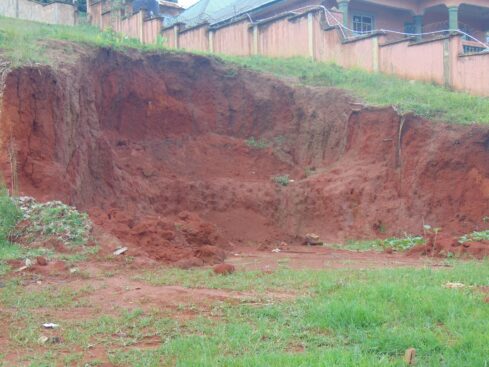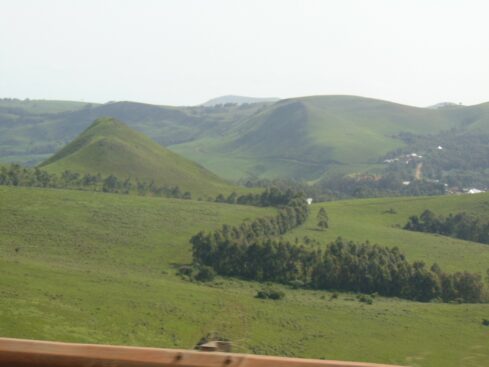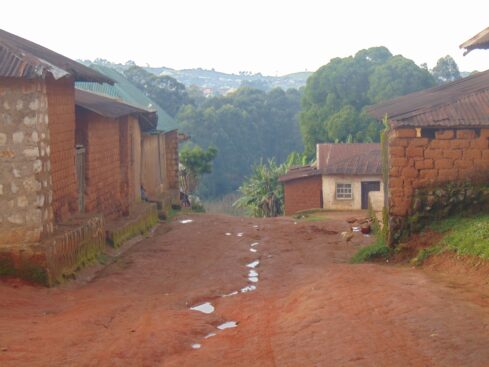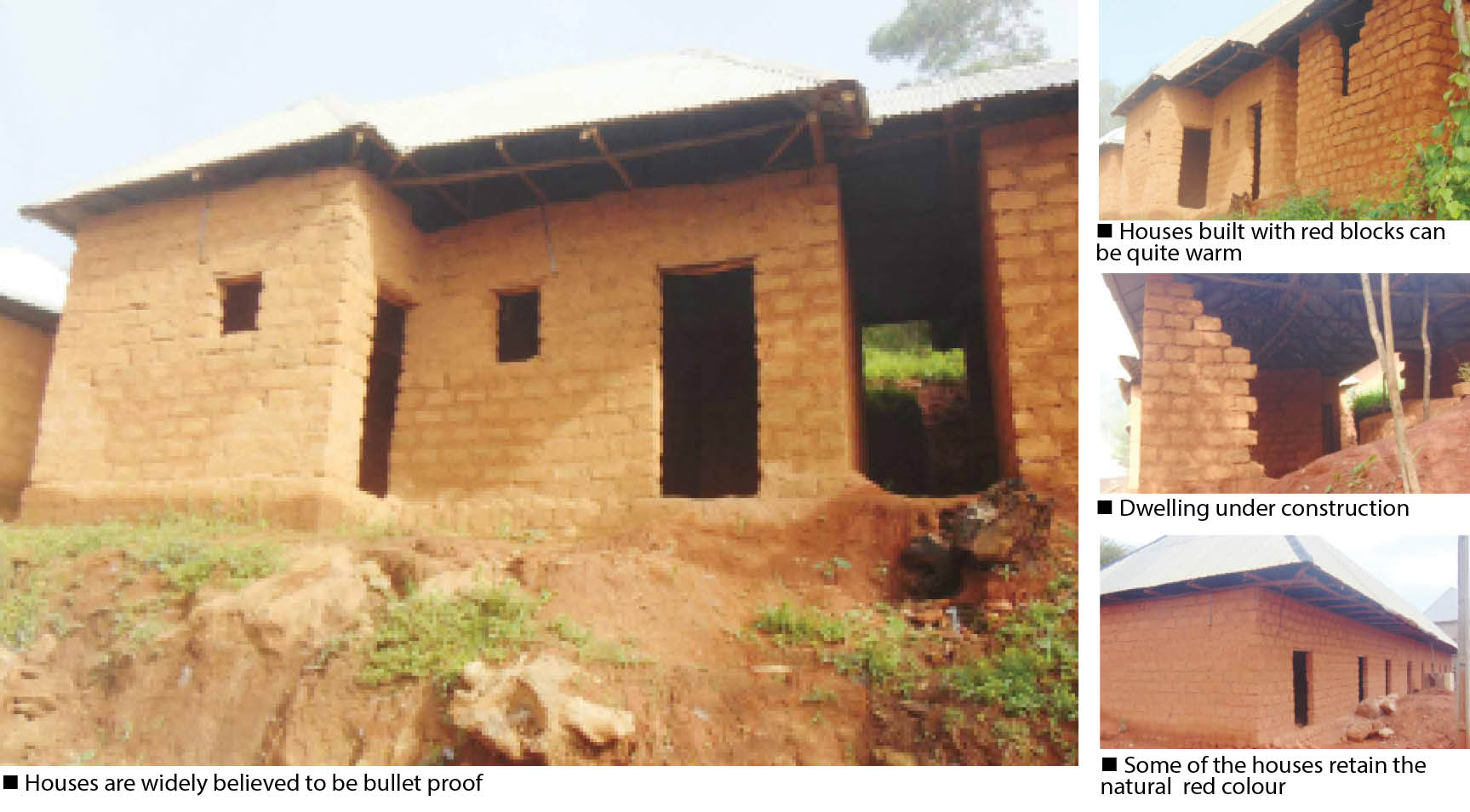In Gembu, many of the houses are built using red blocks, and an industry has arisen around red soils, the raw material required to make the blocks. Houses constructed are not only widely believed to be ‘bullet proof’, but they are said to last 100 years. This is one traditional building system which aids the locals as they construct and decorate their dwellings, year in, year out.
Upon arriving Gembu in Taraba State, you notice the abundant red soil in the community, which is ringed by mountains, hills, and valleys, and is one of the most scenic spots in Nigeria. This comes as a bit of a shock because information generated by google draws attention to the hills, mountains and many scenic delights of the area, but, except for one scholarly article, does not refer to red or reddish brown soils and red buildings in relation to Gembu. It is not clear why there is this gap in terms of information on this aspect of the community. It is ironical that red soils and houses built using red blocks are everywhere in the community, but there are very few references to this online. Let us now examine various aspects of the red block ecosystem in Gembu.
Red sand

The red soil is used to make blocks which are important in the construction of houses or other buildings. This is the rich architectural heritage of the communities on the plateau, and explains the colours which define and characterise Gembu. Everywhere you turn in Gembu, whether you are walking or on a motorcycle, going up a hill or downhill, or just viewing the town from any elevated spot, you will see an endless dazzling spread of red buildings. Infact, there are various shades of red to be seen, and these collectively become a rainbow of red colours. Many of these houses are built within Gembu’s deep stunning valleys. In the local Kaka language red sand is known as Nchack, while the red sand block is referred to as Nchack Ma-Bang.
- Fraud: EFCC nabs impersonators of Evang Ebuka Obi
- THE BEARING: Would You Rather Marry A Career Woman Or A Full Housewife?
An impressive sight

It is both inspiring and beautiful when at dawn or at sunset, sunlight gently falls upon the red buildings or houses, especially those built on the gently sloping hill side. These red houses can also be found by the side of sloping pathways, of which there are numerous in Gembu. It is always a memorable event, if you are in the valley and you look upwards as radiant sunlight falls on the dwellings above you, easily picking out the shades of red. In the valleys, on the hillside and within the town itself, can be found various spots where red soil is excavated. Then there are the countless houses in Gembu and surrounding communities, which cut an impressive sight wherever they are located, and have been built using red blocks and a few other materials. Some buildings are made of pure red blocks, while others, though using the red block as an essential building item, have been plastered with cement. Government does not seem to have intervened in the red block ecosystem, either to improve, mechanise or transform the sector. It has been left to a few local players who have, despite limitations, been able to regulate the economy, and have kept the red soil heritage alive.
‘Bullet proof’

Many people in Gembu believe that the houses are bullet proof. Jonah Jumla, a farmer, comments, “The blocks are bullet proof. It has been proven and I have seen it many times.” To prove that the blocks are strong and resilient, he brings an old red block from a nearby house, which he says is well over 50 years old.
He reveals that the red blocks have some level of popularity within the country, “People from Benue come here to buy our blocks. The houses built with red blocks are usually very warm when it gets cold. Such houses can last for well over 30 years.” Gembu can get very cold and his words make a lot of sense.
Umaru Gona, who hails from Gembu, has been building houses using red blocks for the past 60 years. He is busy at work, raising another building using red blocks, when we meet him. Hear him, “A house made with red blocks can last 100 years.” He mentions that he has seven masons working with him, and that he can build 10 houses, made of red blocks, in any given year. Gembu is a rural community located in a border region, and the regulations around building a house may not be as complicated as will be found in a state capital.
“The red block is bullet proof. I have no doubt that it is bullet proof”, adds Mohammed Musa, a major player in the red soil ecosystem. He has produced a machine which is made of iron and increases the number of blocks that can be produced each day.
Yakubu Maiwada, who holds the title of Jauro Kaka, comments on the strength of blocks made from red soil, “It is a bullet proof block and is one of the best. If a gun is fired now, the bullet would not penetrate a house made of red blocks.”

Osogbo
All of a sudden memories of a similar scene return. During my visit to Osogbo some years ago to cover the Osun Osogbo festival, several buildings constructed using red earth, similar to the ones seen in Gembu, were noticed close to the sacred grove of the Osun goddess. The guide at the time also revealed that the buildings constructed with red blocks are ‘bullet proof.’ Two communities, one in Nigeria’s North-east and the other in the country’s South-west, believe that the red blocks produced in each community are ‘bullet proof.’ These are created from red soils which occur naturally in the environment.
A natural gift

Umaru Zubairu is the Wakilin Mambila, a title holder in Gembu. He sheds light on the red soils of Gembu “It’s a natural gift and it has some sort of cement in it. It is very strong, it’s not like the ones in other parts of the country. Ours is different, and that’s why the blocks here are very strong. If you build, mix the mud and build the blocks, it will turn out to be very strong. It lasts for a long time, and it’s because of the kind of soil we have here.”
“The blocks will last for long, you can build your house with it. Even bullets cannot penetrate it. If you roof it or if you do not roof it, rain will be falling on the building and it will not collapse,”explains Abubakar Hamma’adama, the Wakilin Kaka, another title holder.
Types of soils

Hamma’adama opens up on the different types of red soils on the Mambila plateau. “If you go to other parts of the plateau like Leme, which is very close to Gembu, the soil there, is not starchy. If water touches it, the bricks will melt. It is different from the soil or the earth we get here in Gembu. The one in Gembu contains a lot of starch. If you go to Nguroje, the red earth doesn’t have starch.”
Local building culture
“Red earth is part of the culture of building of the people of the plateau. Our family house here, the building where my late father was staying, the building is there, and he died about 41 years ago. One local building that they built in those days, the building is still there. That building is almost 100 years old. It has been exposed to the effects of weathering, but its still standing,” he emphasizes.
It won’t break

Musa has played a role in ennobling the red block ecosystem in Gembu. His words: “If we wish to make the red block stronger, we can buy firewood and burn it and apply it. If you then throw the block on the ground, it will not break. Some of those involved in making red blocks, make use of grass as they are making the block. The red block is bullet proof. I have no doubt that it is bullet proof.”
400 blocks

According to him “I decided to create the machine because many people need the block, the demand for it is high. In the past the workers make 300 blocks per day, but with the new machine we make more than 400 blocks. This one has more weight than the previous type, but the quality is higher.”
He sheds more light on the use of red blocks by local builders “Many houses in Gembu are built with red soil, but plastered with cement. The people who use red blocks to build houses in this town are uncountable. There are some who, in addition, will plaster their houses with cement.”
Repairs
Jumla states that maintenance around the houses is sometimes done. “The houses have to be maintained from time to time. If there is a crack they will mix the red earth and attend to the weak spot. People construct storey buildings and any other type of building, with red earth. It is an activity carried out by men.”
No schools

Zubairu speaks on the absence of tertiary institutions in Gembu: “One problem we are having here is the fact that we don’t have higher institutions. Apart from secondary schools, there are no universities or polytechnics. We don’t know the reason for this. This place will be good for studies, because of the weather, it’s not so harsh, and it’s not so cold. People will enjoy studying here.”
This may explain why the red block ecosystem has been left to the locals. There is no form of capacity development, or support in terms of loans, which will jointly preserve or deepen this system of traditional architecture.
He argues: “Whether you mix it with grass or you don’t, the blocks will be strong. Nowadays, they don’t mix it with grass. Formerly, our people built without the blocks. They were mixing the earth with grass, then they will build but not with the use of blocks. But the ones they build with blocks today, do not make use of grass, and it’s still okay.”
Different soils
Hamma’adama comments further on different types of red soils in Gembu. “The red soil is here in Gembu. On the Mambila plateau anywhere you go, you can see the red soil. But the red soils differ. If you go to other parts of the plateau, the red earth is red and starchy, you can mould bricks with it. The blocks will last for long, you can build your house with it.”
“If you grow crops like Irish potato in areas where the soil does not have starch, it will do well, much more than areas where the soil has starch. Irish potato will not do well in Gembu. Every place has its own advantage and disadvantage,” he reveals.
Red blocks are part of the heritage of Gembu, he states, “Red earth is part of the culture of building of the people of the plateau.”
Strong, powerful
“If you go to the local governments around us here, like Gashaka local government, people go to Maisamari to buy their bricks there and return to Gashaka to build their houses. The bricks are very strong and powerful, and that is why they come up here to buy the bricks,” he says, shedding light on the local building culture and relationships between communities.

Youths
The younger generations are also quite keen on the red block, “Our boys who are working in Abuja and other places, even outside Nigeria, when they come here, and wish to build their house, most of them use the red blocks moulded with clay.”
Hamma’adama explains, “This is because the clay is not negatively impacted upon by water, it rains here a lot. If the building is cool, it will not collapse. If you use cement blocks here, if it receives a lot of water, you will see the block cracking and the building will collapse.”
Interesting process
Hamma’adama describes an unforgettable process. “In those days, the red clay is what people use in their houses. Then cement was not available. They place the clay in the house, and level it on the floor with their hoe. After leveling it, they will bring water and spray on it. They will also get banana leaves and put on top. They will get sticks and hit the earth, while applying water, until it becomes strong. When it is dry, it will now be similar to a house with a cement floor. At that time there was no cement, so people will just enter a house and start to sleep.”
Hamma’adama makes a confession. “If it comes to durability, the house built with red bricks, is more powerful, more durable than those built with cement blocks. It also lasts for long.”
Musa posits. “Red block is stronger than cement blocks. Sometimes, we mix it with gravel, or small cement.”
Cheap
The red blocks are not expensive and this may explain their popularity in Gembu. “The new type which we make with the machine, costs N90 per block, while the old one costs N20 per block. We cannot make more than 400 in a day because of the weight of the block. It’s known as a moulding machine. This one is made of iron, it’s known as presser, while the other type is made of wood.”
He provides an idea of the various houses in Gembu, built using red blocks. “Many houses are built with red soil, but plastered with cement. People who use red blocks to build houses in this town are uncountable. There are some who, in addition, will plaster the house with cement.”
“In the earlier system of making red blocks, the people wait a bit before the blocks are ready, but with this one we don’t wait. We don’t wait because it is a presser machine and it produces the blocks immediately.
“I can pay my bills from the earnings I make. More than eight persons work with me here every day. I learnt many things relating to making blocks from red sand, owing to the condition in the county today,” Musa adds.
Lack of water

Gembu lacks water. “If we can have water here, it will help. We do more work in the rainy season, but in dry season we don’t have much water here. Therefore, lack of water affects our work and slows it down. Sometimes, we produce less than 400 blocks. Absence of water is a huge setback to the red block economy,” Musa reiterates.
Process of block making
Gona talks about the rudimentary process of moulding the red blocks. “We take water and step on it. We use our feet to mix the soil. We use one week to dry the soil. Then we put grass if we see that it will crack. If there is laterite we put grass, soil without laterite does not need grass. One week is enough for the soil to solidify.
“The younger generations are still interested in the red block culture. A house built with red blocks can last a hundred years. There are up to 600 workers in the red block industry in Gembu.”
Good workman

Gona opens up on the qualities that help to define a good work man in the business. “It is easy to identify a good workman. We have a digger to dig the soil. How he holds the digger, the entire process of mixing the soil, helps you identify a good workman who builds using red blocks.”
He speaks on developments within the process of block making across the years. “Years ago when we began building with red blocks, we did not have cement, we were just using mud. Now, we are getting cement, and we are building with cement, and we are plastering with cement.”
Red blocks using elements of cement to plaster the building, are major aspects in modern building styles.
Strong red blocks
Hamma’adama opens up on the process of producing excellent blocks. “If we can move round, to see buildings constructed using clay, the red earth, they used to put grasses inside to improve the starch element, better than the original one. If you want to make the block to be very powerful, during the rainy season, as rain is falling, you will see youths going round. They will fetch the water and then mould the earth.”
He describes other aspects of the process, “They will use their legs, stepping on it, cut grass into pieces, and put it inside the soil. They will put it aside during the rainy season, they will not touch it. It will remain and they will bring banana or plantain leaves, and cover the already moulded clay or soil. When they cover it, it will be like that until the dry season. When the dry season comes, the grass they use in moulding the soil has become rotten, and it will give more starch to the soil. That is how strong red blocks are made.”
Heritage of Gembu

Maiwada stresses, “People build storey buildings using red blocks. They use it to build standard houses. This is part of the heritage of Gembu. The best form is the red earth. Houses made from red earth can be quite warm and strong.
“The Lord gave us this land. We make our blocks here with mud, gather red sand and step on it with our feet for four days before moulding the blocks,” reveals Jumla.
He is describing a home grown process that has endured, almost unchanged, for hundreds of years within the serene valleys and hills of the Mambila plateau. Gembu is an area filled with enchanting mountain ranges, which attract those who love the outdoors and enjoy daily walks and adventure.

 Join Daily Trust WhatsApp Community For Quick Access To News and Happenings Around You.
Join Daily Trust WhatsApp Community For Quick Access To News and Happenings Around You.


